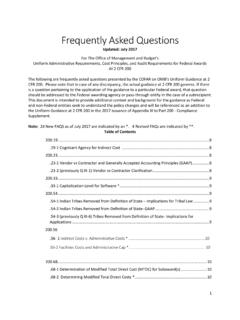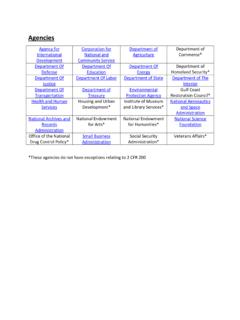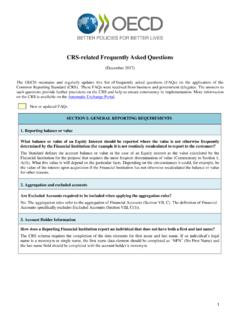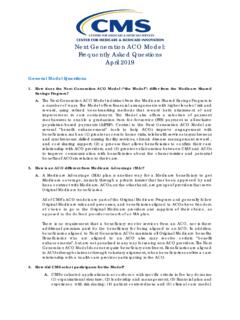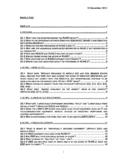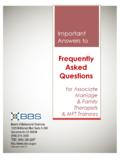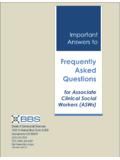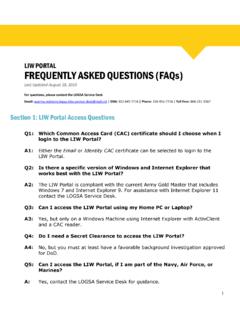Transcription of Frequently Asked Questions - cfo.gov
1 1 Frequently Asked Questions Updated: September 2015 For The Office of Management and Budget s Uniform Administrative Requirements, Cost Principles, and Audit Requirements for Federal Awards At 2 CFR 200 The following are Frequently Asked Questions presented by the COFAR on OMB s Uniform Guidance at 2 CFR 200. Please note that in case of any discrepancy, the actual guidance at 2 CFR 200 governs. If there is a question pertaining to the application of the guidance to a particular Federal award, that question should be addressed to the Federal awarding agency or pass-through entity in the case of a subrecipient. This document is intended to provide additional context and background for the guidance as Federal and non-Federal entities seek to understand the policy changes and will be referenced as an addition to the Uniform Guidance at 2 CFR 200 in the 2015 issuance of Appendix XI to Part 200 - Compliance Supplement. Note: New FAQS as of September, 2015 are indicated by an *.
2 Revised FAQs by **. In addition, the following FAQs have be renumbered without a change in content: FAQs .320-4 through 6 have been renumbered .320-3, .320-4 and .320-5 and FAQs .414-3 through 5 have been renumbered .414-4, . and .414-6 Table of Contents .. 6 .19-1 Cognizant Agency for Indirect Cost * .. 6 .. 7 .23-1 Vendor vs Contractor and Generally Accepted Accounting Principles (GAAP) .. 7 .23-2 (previously Q III-1) Vendor vs Contractor Clarification .. 7 .. 7 .54-1 Indian Tribes Removed from Definition of State Implications for Tribal Law .. 7 .54-2 Indian Tribes Removed from Definition of State- GAAP .. 8 .54-3 (previously Q III-6) Tribes Removed from Definition of State- Implications for Applications .. 8 .. 8 .68-1 Determination of Modified Total Direct Cost (MTDC) for Subaward(s) * .. 8 .. 8 .70-1 Eligibility of Institutions of Higher Education (IHE) for Funding Opportunities which are Limited to Nonprofit Organizations * .. 8 .. 9 2.
3 101-1 Applicability of Uniform Guidance to Federal Acquisition Regulation (FAR) based contracts .. 9 .101-2 (also applicable to ) Audit Requirements of FAR based contracts in addition to the Uniform Guidance Audit Requirement .. 9 .101-3 (also applicable to ) Cost Accounting Standards (CAS) and the Uniform Guidance .. 9 .. 10 .110-1 Effective Dates and Indirect Cost Rates .. 10 .110-2 Effective Dates and Indirect Cost Rate Proposals .. 10 .110-3 Effective Dates and Disclosure Statements (DS-2s) .. 10 .110-4 Effective Dates and Applications .. 10 .110-5 Effective Dates, Applications, and DS-2s .. 11 .110-6 Effective Dates and Grace Period for Procurement ** .. 11 .110-7 Effective Dates and Incremental Funding .. 11 .110-8 Effective Dates and Formula & Entitlement Programs .. 12 .110-9 Effective Dates and Consistent Implementation (Federal) .. 12 .110-10 Effective Dates and Consistent Implementation (States) .. 12 .110-11 Effective Dates and Subawards .. 12 .110-12 (updated from previous Q II-1) Effective Dates.
4 12 .110-13 (Previously Q II-2) Effective Dates and Federal Awards Made Previously .. 12 .110-14 (Previously Q II-3) Effective Dates and Pre-Existing Guidance .. 13 .110-15 (Updated from the previous Q II-4) Single Audit Compliance Supplement and Audit Resolution .. 13 .. 13 .112-1 Conflict of Interest .. 13 .112-2 Conflict of Interest Scientific Collaborations * .. 14 .. 14 .201-1 Fixed Amount Awards .. 14 .201-2 Fixed Amount Awards and Cost-share or Match .. 14 .201-3 Fixed Amount Awards and End of Award Certifications .. 14 .. 15 .203(a) Notices of Funding Opportunities .. 15 .. 15 .205-1 Review of Risk Posed by Applicant- Financial Stability .. 15 3 .. 15 .303-1 Should vs Must and Internal Controls .. 15 .303-2 (previously Q III-5) Should vs. Must In General .. 15 .303-3 (Previously Q III-4) Should vs Must and the Green book .. 16 .. 16 .305-1 Application of (b) advance payments to payments by States * .. 16 .. 16 .306-1 Exceptions in Statute for restrictions on cost sharing or matching.
5 16 .. 16 .307-1 Fees and Royalties and Bayh-Dole .. 16 .. 17 .309-1 (Updated from the previous Q III-2) Period of Performance and No-Cost Extension . 17 .. 17 .313-1 Equipment and Conditional Title .. 17 .313-2 Changes to Equipment Inventory Systems .. 17 .. 18 .318-1 (Previously Q III-7) Equipment and A-110 Screening Procedures .. 18 .. 18 .320-1 Methods of Procurement Micro vs Small vs Over Threshold .. 18 .320-2 Methods of Procurement- Sole Source for Research ** .. 19 .320-3 Methods of Procurement and Strategic Sourcing and Shared Services .. 19 .320-4 Methods of Procurement and Charge Cards .. 19 .320-5 Methods of Procurement and Indirect Costs .. 19 .. 20 .323-1 Negotiation of profit * .. 20 .. 20 .331-1 Pass-through Entities, Indirect Cost Rates, and State Funds .. 20 .331-2 Limits on layers of Subrecipients for Indirect 20 .331-3 Delayed Federal funds and Indirect Cost Rates .. 20 .331-4 Indirect Cost Rates and Blended Subawards .. 20 .331-5 Indirect Cost Rates and Entities Who Do Not Have Indirect Costs.
6 21 .331-6 Pass-through Entities and Indirect Cost Rate Negotiation .. 21 .331-7 Indirect Cost Rates and non-Compliance with Guidance .. 21 4 .. 21 .332-1 Fixed Amount Subawards .. 21 .. 22 .400-1 Fixed Amount Subawards and Profit .. 22 .400-2 Dual Role of Students and Post-Doctoral Staff .. 22 .400-3 (Previously Q III-3) Profit and Nonprofits .. 22 .. 22 .401-1 Fixed Amount Awards and Cost Principles .. 22 .. 23 .403-1 Requirement for Compliance with Applicable Laws and Regulations * .. 23 .. 23 .413-1 What Counts as Prior Approval .. 23 .. 23 .414-1 De Minimis Rate and Governments .. 23 .414-2 Indirect Cost Rate Extensions Current and one-time .. 23 .414-3 Documentation Required for Extension .. 24 .414-4 Timing of Request for Extension .. 24 .414-5 Extensions and Fixed-Rates with Carry-Forward .. 24 .414-6 (Previously Q IV-3) Extensions and Old Rates, Shorter Extensions .. 24 .414-7 Extensions of Final Rates* .. 25 .414-8 (Also applicable to ) Federally negotiated indirect cost rates voluntary under-charging or waiving IDC *.
7 25 .414-9 De Minimis Rate and Breaks in Federal Relationship * .. 25 .414-10 De Minimis Rate and Period of Applicability * .. 25 .414-11 De Minimis Rate and non-Federal entity with Single Function * .. 26 .. 26 .415-1 Authorization to Legally Bind the non-Federal entity .. 26 .. 26 .425-1 Audits not Required in Accordance with Single Audit * .. 26 .425-2 Financial Statement Audit * .. 26 .425-3 Performance Audits * .. 27 .425-4 Financial Statement Audits by Entities Exempted from Single Audit and Subpart F * 27 .425-5 Internal Audit Functions * .. 27 5 .. 27 .430-1 Authorization of Changes to Time and Effort Systems .. 27 .430-2 Time and Effort and Tribes .. 27 .. 28 .431-1 Fringe Benefits and Indirect Costs ** .. 28 .431-2 Charging Payments of Unused Leave to Employees Terminating or Retiring * .. 28 .. 28 .436-1 Depreciation and Cost Sharing .. 28 .436-2 (Previously Q IV-1) Depreciation and Cost 28 .. 29 .440-1 Prior Approval for Fluctuations in Exchange Rates.
8 29 .. 29 .444-1 Salaries and wages for Tribal Councils .. 29 .. 29 .449-1 Interest Costs for Computer Software Development * .. 29 .. 29 .458-1 Pre-Award 29 .458-2 (Previously Q IV-2) Uncommitted Cost Sharing .. 29 .. 30 502-1 Basis for determining Federal awards expended * .. 30 .. 30 .504-1 Audited Financial Statements not required by Single Audits * .. 30 .. 30 .512-1 Tribes Opting out of Online Report Publication- Definition of Tribal Entities .. 30 .512-2 Availability of Reports for Public Inspection .. 30 .512-3 Waivers for low-risk auditee standards .. 31 .512-4 (Previously Q V-1) Application of Option Not to Publish for Tribes .. 31 .512-5 (Previously Q V-2) Single Audit Accountable Official .. 31 .. 32 .513-1 Government Wide Audit Quality Project * .. 32 .. 32 .515-1 Compliance with GAAP * .. 32 Appendix III .. 32 6 Appendix III-1 Utility Cost 32 Appendix III-2 Utility Costs Adjustment Determination * .. 32 Appendix III 3 Salaries above the HHS/NIH Statutory Limitation Inclusion in MTDC Base*.
9 33 Appendix V .. 33 Appendix V-1 SWCAP For Tribes .. 33 Previous FAQs Background on Uniform Guidance .. 33 I - Process and Background .. 33 Q I-1: When and why did we begin this process? .. 33 Q I-2: How have we engaged stakeholders over the past two years? .. 34 Q I-3: How does this reform complement OMB s work on the Evidence Agenda? .. 34 Q I-4: Did OMB hold formal consultations with Indian Tribes? .. 34 Q I-5: Who will be impacted by this reform? .. 34 Q I-6: Where can I get more information about the policies that are changed? .. 34 Q I-7: What is the impact of this reform? How does this reform reduce administrative burden and risk of waste, fraud, and abuse? .. 35 Q I-8: Why and how did the COFAR reach some of the particular policy recommendations that they did? What are the major differences between the final guidance and the proposed guidance? Can you give us an example of a policy call where the COFAR had to make some tough tradeoffs and share some of the thinking behind the decision?
10 36 Q I-9: What are the other COFAR priorities this year? .. 37 Q I-10: Reponses to comments. Beyond the preamble to the Federal Register notice publishing .. 37 2 CFR 200 (and the provisions themselves), does OMB plan any further responses to the comments of those who responded to the February 2013 version? .. 37 Attachment 1: Procurement Bear claw .. 37 .19-1 Cognizant Agency for Indirect Cost * If the Federal awarding agency serving as the cognizant agency for indirect costs for a non-Federal entity (as described in section Cognizant agency for indirect costs) does not allow the non-Federal entity to claim indirect costs, is this Cognizant agency still responsible for negotiating indirect cost rates? Yes. When a Federal awarding agency is the Cognizant agency for indirect costs and does not allow recipients to recover indirect costs on their awards, it is the responsibility of the cognizant agency for indirect costs to negotiate indirect costs rates.
